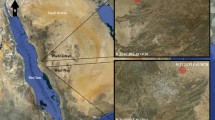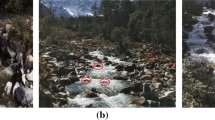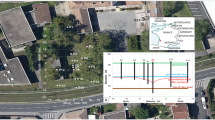Abstract
Hydraulic conductivities associated with measurement scale of the order of 10–1 m and collected during an extensive field campaign near Tübingen, Germany, are analyzed. Estimates are provided at coinciding locations in the system using: (1) the empirical Kozeny-Carman formulation, providing conductivity values, K GS, based on particle-size distribution, and (2) borehole impeller-type flowmeter tests, which infer conductivity, K FM, from measurements of vertical flows within a borehole. Correlation between the two sets of estimates is virtually absent. However, statistics of the natural logarithm of K GS and K FM at the site are similar in terms of mean values (averages of ln K GS being slightly smaller) and differ in terms of variogram ranges and sample variances. This is consistent with the fact that the two types of estimates can be associated with different (albeit comparable) measurement (support) scales. It also matches published results on interpretations of variability of geostatistical descriptors of hydraulic parameters on multiple observation scales. The analysis strengthens the idea that hydraulic conductivity values and associated key geostatistical descriptors inferred from different methodologies and at similar observation scales (of the order of tens of cm) are not readily comparable and should not be embedded blindly into a flow (and eventually transport) prediction model.
Résumé
Des conductivités hydrauliques associées à des échelles de mesure de l’ordre de 10–1 m et acquises pendant une vaste campagne près de Tübingen, Allemagne, sont analysées. Les valeurs sur site sont fournies par : (1) la formule empirique de Kozeny-Carman qui donne une valeur de conductivité K GS basée sur la distribution granulométrique (2) des tests de débitmétrie micro moulinet, qui donnent la conductivité K FM par mesure de débit vertical. Une corrélation entre les deux séries d’estimations est pratiquement exclue. Cependant, les distributions statistiques des logarithmes népériens de K GS et K FM sont comparables en termes de valeurs moyennes (les moyennes de ln K GS étant légèrement plus faibles) et diffèrent en termes d’écarts du variogramme et de la variance. Ceci est cohérent avec le fait que deux types d’estimations peuvent être associés à différentes (bien que comparables) échelles de mesure (support). Ceci correspond aussi aux résultats publiés sur l’interprétation de la variabilité des descripteurs géostatistiques des paramètres hydrauliques sur des échelles d’observation multiples. L’analyse conforte l’idée selon laquelle les valeurs de conductivité hydraulique et les principaux descripteurs géostatistiques associés, déduits de différentes méthodologies et à des échelles d’observation similaires (de l’ordre de la dizaine de cm) ne sont pas directement comparables et ne devraient pas être insérées aveuglément dans un modèle de prévision d’écoulement (et finalement de transport).
Resumen
Se analizaron las conductividades hidráulicas asociadas con escalas de medidas del orden de 10–1 m y recolectadas durante una extensiva campaña de campo cerca de Tübingen, Alemania. Las estimaciones son provistas en localidades coincidentes en el sistema usando: (1) la formulación empírica de Kozeny-Carman, que provee valores de conductividad, K GS, basados en la distribución del tamaño de partículas, y (2) pruebas en pozos con un medidor de flujo con impulsor, lo cuales infieren la conductividad, K FM, a partir de mediciones de flujos verticales dentro del pozo. La correlación entre los dos conjuntos de estimaciones está de hecho ausente. Sin embargo, la estadística de los logaritmos naturales de K GS y K FM en los sitios son similares en términos de los valores medios (siendo los promedios del ln K GS ligeramente menores) y difiere en términos de los intervalos del variograma y de las varianzas de la muestra. Esto es consistente con el hecho que los dos tipos de estimaciones pueden estar asociados con diferentes (aunque comparables) escalas de medidas (de apoyo). También coincide con resultados publicados en la interpretación de la variabilidad de los descriptores geoestadísticos de los parámetros hidráulicos en múltiples escalas de observación. Los análisis refuerzan la idea que los valores de conductividad hidráulica y los asociados descriptores geoestadísticos claves inferidos a partir de diferentes metodologías y en las escalas de observación similar (del orden de decenas de cm) no son apropiadamente comparables y no deben ser incorporados a ciegas en un modelo de predicción de flujo (o finalmente de transporte).
Resumo
Analisam-se as condutividades hidráulicas associadas à escala de medição da ordem de 10–1 m de amostras recolhidas durante uma extensa campanha de campo perto de Tübingen, na Alemanha. Há estimativas fornecidas para locais coincidentes no sistema utilizando: (1) a fórmula empírica de Kozeny-Carman, fornecendo valores de condutividade, K GS, baseados na distribuição do tamanho de partículas, e (2) testes do tipo medidor de fluxo, que inferem a condutividade, K FM, a partir de medições de fluxos verticais dentro de um furo. Verificou-se que a correlação entre os dois tipos de estimativas é praticamente nula. Contudo, as estatísticas do logaritmo natural de K GS e de K FM no local são semelhantes em termos de valores médios (as médias do ln K GS sendo ligeiramente menores) e diferem em termos de escalas de variogramas e variâncias da amostra. Isto é consistente com o facto de que os dois tipos de estimativas podem estar associados a diferentes (embora comparáveis) escalas de medidas. Coincide, também, com os resultados publicados sobre interpretações de variabilidade de descritores geoestatísticos de parâmetros hidráulicos em múltiplas escalas de observação. A análise reforça a ideia de que os valores de condutividade hidráulica e os associados descritores geoestatísticos chave, inferidos a partir de diferentes metodologias, e a escalas de observação similares (da ordem de dezenas de centímetros), não são facilmente comparáveis e não devem ser incorporados às cegas num modelo de previsão de escoamento (e eventualmente de transporte).




Similar content being viewed by others
References
American Association for Laboratory Accreditation (2005) P103d-Annex: policy on estimating measurement uncertainty for construction materials & geotechnical testing labs. AALA, Frederick, MD
Barr DW (2005) Discussion of “Goodbye Hazen; hello, Kozeny-Carman” by W. David Carrier III. J Geotech Geoenviron Eng 131(8):1057–1058
Beckie R (1996) Measurement scale, network sampling scale, and groundwater model parameters. Water Resour Res 32(1):65–76
Beyer W (1964) Zur Bestimmung der Wasserdurchlässigkeit von Kiesen und Sanden aus der Kornverteilungskurve [On the determination of the hydraulic conductivity of gravel and sand based on grain size distribution]. Wasserwirt Wassertech 14(6):165–169
Boman GK, Molz FJ, Boone KD (1997) Borehole flowmeter application in fluvial sediments: methodology, results, and assessment. Ground Water 35(3):443–450
Butler JJ (2005) Hydrological methods for estimation of spatial variations in hydraulic conductivity. In: Rubin Y, Hubbard S (eds) Hydrogeophysics. Springer, Dordrecht, The Netherlands, pp 23–58
Cardenas MBR, Zlotnik VA (2003) Constant-head injection tests: a simple method for streambed permeability estimation. Ground Water 41(6):867–871
Carrier WD (2003) Goodbye, Hazen; hello, Kozeny-Carman. J Geotech Geoenviron Eng 129(11):1054–1056
Cheng C, Chen X (2007) Evaluation of methods for determination of hydraulic properties in an aquifer–aquitard system hydrologically connected to a river. Hydrogeol J 15:669–678
Custodio E, Llamas MR (1984) Hidrología subterránea [Subterranean hydrogeology]. Barcelona, Spain
Fetter CW (2001) Applied hydrogeology. Englewood Cliffs, NJ
Fogg GE, Noyes CD, Carle SF (1998) Geologically based model of heterogeneous hydraulic conductivity in an alluvial setting. Hydrogeol J 6:131–143
Gallardo AH, Marui A (2007) Hydraulic characteristics of sedimentary deposits at the J-PARC proton-accelerator, Japan. Earth Sci Res J 11(2):139–154
Hess KM, Wolf SH, Celia MA (1992) Large-scale natural gradient tracer test in sand and gravel, Cape Cod, Massachusetts, 3: hydraulic conductivity variability and calculated macrodispersivities. Water Resour Res 28(8):2011–2027
Hufschmied P (1986) Estimation of three-dimensional statistically anisotropic hydraulic conductivity field by means of a single well pumping test combined with flowmeter measurements. Hydrogeologie 2:163–174
International Organization of Standardization-GUM (1995) Guide to the expression of uncertainty in measurements. JCGM, Pavillon de Breteuil, France, pp 1–15
Kasenow M (2002) Determination of hydraulic conductivity from grain size analysis. Water Resources, LLC, Highlands Ranch, CO, pp 47–84
Martac E, Ptak T (2003) Data sets for transport model calibration/validation, parameter upscaling studies and testing of stochastic transport models/theory. Report D16 of Project “Stochastic Analysis of Well-Head Protection and Risk Assessment—W-SAHaRA”, EU contract EVK1-CT-1999-00041, Dipartimento Ingegneria Idraulica, Ambientale, Infrastrutture Viarie, Rilevamento, Politecnico di Milano, Milan, Italy
Molz FJ, Morin RH, Hess AE, Melville JG, Güven O (1989) The impeller meter for measuring aquifer permeability variations: evaluation and comparison with other tests. Water Resour Res 25(7):1677–1683
Molz FJ, Bowman GK, Young SC, Waldrop WR (1994) Borehole flowmeters: field application and data analysis. J Hydrol 163(3–4):347–371
Neuman SP, Di Federico V (2003) Multifaceted nature of hydrologic scaling and its interpretation. Rev Geophys 41(3):1014. doi:10.1029/2003RG000130
Neuman SP, Blattstein A, Riva M, Tartakovsky DM, Guadagnini A, Ptak T (2007) Type curve interpretation of late-time pumping test data in randomly heterogeneous aquifers. Water Resour Res 43(10):W10421
Neuman SP, Riva M, Guadagnini A (2008) On the geostatistical characterization of hierarchical media. Water Resour Res 44(2):W02403
Odong J (2007) Evaluation of empirical formulae for determination of hydraulic conductivity based on grain-size analysis. J Am Sci 3(3):54–60
Payne FC, Quinnan JA, Potter ST (2008) Remediation hydraulics. Boca Raton, FL
Rehfeldt KR, Hufschmied P, Gelhar LW, Schaefer ME (1989) The borehole flowmeter technique for measuring hydraulic conductivity variability. Report no. EN 6511. Electric Power Research Institute, Palo Alto, CA
Riva M, Guadagnini L, Guadagnini A, Ptak T, Martac E (2006) Probabilistic study of well capture zones distributions at the Lauswiesen field site. J Contam Hydrol 88:92–118
Riva M, Guadagnini A, Fernandez-Garcia D, Sanchez-Vila X, Ptak T (2008) Relative importance of geostatistical and transport models in describing heavily tailed breakthrough curves at the Lauswiesen site. J Contam Hydrol 101:1–13
Riva M, Guadagnini L, Guadagnini A (2010) Effects of uncertainty of lithofacies, conductivity and porosity distributions on stochastic interpretations of a field scale tracer test. Stoch Environ Res Risk Assess 24:955–970
Sack-Kühner BT (1996) Einrichtung des Naturmeßfeldes “Lauswiesen Tübingen”, Erkundung der hydraulischen Eigenschaften, Charakterisierung der Untergrundheterogenität und Vergleich der Ergebnisse unterschiedlicher Erkundungsverfahren [Installation of the natural measuring field “Lauswiesen Tübingen”, investigation of the hydraulic characteristics, characterization of the underground heterogeneity and comparison of the results for different investigation procedures]. MSc Thesis, University of Tübingen, Germany
Sanchez-Vila X, Guadagnini A, Carrera J (2006) Representative hydraulic conductivities in saturated groundwater flow. Rev Geophys 44(3):RG3002
Stauffer TB, Manoranjan VS (1994) The use of grain-size analysis field-data to study hydraulic conductivity variability. Aviat Space Environ Med 65(5):A125–A130
Tidwell VC, Wilson JL (1999a) Permeability upscaling measured on a block of Berea sandstone: results and interpretation. Math Geol 31(7):749–769
Tidwell VC, Wilson JL (1999b) Upscaling experiments conducted on a block of volcanic tuff: results for a bimodal permeability distribution. Water Resour Res 35(11):3375–3387
Vukovic M, Soro A (1992) Determination of hydraulic conductivity of porous media from grain-size composition. Water Resources, Littleton, CO
Whittaker J, Teutsch G (1999) Numerical simulations of subsurface characterization methods: application to a natural aquifer analogue. Adv Water Resour 22(8):819–829
Wilson AM, Huettel M, Klein S (2008) Grain size and depositional environment as predictors of permeability in coastal marine sands. Estuar Coast Shelf Sci 80(1):193–199
Wolf SH, Celia MA, Hess KM (1991) Evaluation of hydraulic conductivities calculated from multiport-permeameter measurements. Ground Water 29(4):516–525
Young SC (1998) Impacts of positive skin effects on borehole flowmeter tests in a heterogeneous granular aquifer. Ground Water 36(1):67–75
Zlotnik VA, McGuire VL (1998) Multi-level slug tests in highly permeable formations: 2. hydraulic conductivity identification, method verification, and field applications. J Hydrol 204:283–296
Zlotnik VA, Zurbuchen RF, Ptak T, Teutsch G (2000) Support volume and scale effect in hydraulic conductivity: experimental aspects In: Zhang D, Winter CL (eds) Theory, modeling, and field investigation in hydrogeology: a special volume in honor of Shlomo P. Neuman’s 60th Birthday: Boulder, Colorado,” Geological Society of America Special Paper 348, GSA, Boulder, CO, pp 215-231
Zlotnik VA, Zurbuchen BR (2003a) Field study of hydraulic conductivity in a heterogeneous aquifer: Comparison of single-borehole measurements using different instruments. Water Resour Res 39(4). doi:10.1029/2002WR001415
Zlotnik VA, Zurbuchen BR (2003b) Estimation of hydraulic conductivity from borehole flowmeter tests considering head losses. J Hydrol 281:115–128
Acknowledgements
Financial support from the Spanish Ministry of Science and Innovation through projects PARATODO and Consolider-Ingenio 2010 CSD2009-00065 is gratefully acknowledged. The first author was financed by the Consejo Superior de Investigaciones Científicas and the University of Costa Rica PhD scholarship. Additional funding was obtained from GEMINO (Politecnico di Milano, Progetti di ricerca 5 per mille junior). We are grateful to Thomas Ptak of the University of Göttingen in Germany for sharing with us data from the Tübingen site.
Author information
Authors and Affiliations
Corresponding author
Electronic supplementary materials
Below is the link to the electronic supplementary material.
ESM 1
(PDF 169 kb)
Rights and permissions
About this article
Cite this article
Barahona-Palomo, M., Riva, M., Sanchez-Vila, X. et al. Quantitative comparison of impeller-flowmeter and particle-size-distribution techniques for the characterization of hydraulic conductivity variability. Hydrogeol J 19, 603–612 (2011). https://doi.org/10.1007/s10040-011-0706-5
Received:
Accepted:
Published:
Issue Date:
DOI: https://doi.org/10.1007/s10040-011-0706-5




